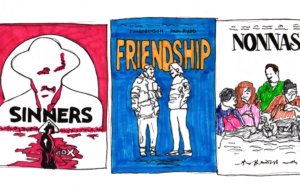Escape reality with a slice of Licorice Pizza
Set in 1970s California, “Licorice Pizza,” directed by Paul Thomas Anderson, is a bizarre, fever dream coming-of-age comedy-drama following an endless summer in the San Fernando Valley suburbs. Shot entirely on 35 mm film, the movie tracks the meeting and interactions between the 25 year old Alana Kane, played by Alana Haim of indie-rock band Haim, and burgeoning teenage actor and entrepreneur Gary Valentine, played by Cooper Hoffman.
Following in the footsteps of Anderson’s past epics, Boogie Nights and Magnolia, the plot is chaotic, offbeat and jarring. That said, “Licorice Pizza” stands out as Anderson’s most personal storytelling through its tone of warmth and wistfulness wrapped up in the orangey-70s glow that covers the entire film.
In many ways, “Licorice Pizza” is a magnificent ode to the long lost Los Angeles suburbs: a series of moments, suspended in the nostalgia that surrounds Anderson’s childhood memories. Haim’s Alana expresses a refusal to grow up even as she ages through her 20s in juxtaposition of Hoffman’s Gary, who wants nothing more than to grow up quicker.
Star-studded with Anderson’s long list of Hollywood friends (not limited to, but including Sean Penn as fading Hollywood actor William Holden and Bradley Cooper as Jon Peters, the controversy-wrapped violent ex-boyfriend of Barbra Streisand), the true success of “Licorice Pizza” lies in its performances. Every character and performance is intentional, from Christine Ebersole’s cruel and perfection-consumed small-time director Lucy Doolittle to Harriet Sansom Harris’s off-putting and visceral casting agent Mary Grady. Of course, Haim’s and Hoffman’s performances, despite being both their debuts, are natural yet transformative.
At its core, however, “Licorice Pizza” is a story of 70s dailyism, an era which refuses to be remembered for the disaster that it was: the Nixon administration, the oil crisis, drug addiction, and an overt presence of racism, sexism, and homophobia. Alana and Gary’s relationship follows the same path—despite Anderson’s attempts at romanticizatizing their flirtations past the audience’s discomfort, their push-and-pull ends in pedophilic glorification. Though the attempt is beautiful, the end result reflects the era: violent, gritty and disastrous.
“Licorice Pizza” presents a compelling and immersive picture of a pair of people on a desperate run to be liberated, at which every turn, they make dangerous and questionable decisions to do so (at one point, Gary is detained for murder, Alana navigates a giant cargo truck traveling with sheer gravity backwards down a mountain, and the two of them flood a client’s house). Neither positive or negative or neutral, “Licorice Pizza” is complex yet simple, angry yet romantic, and beautiful yet ugly: it’s simply a story.


